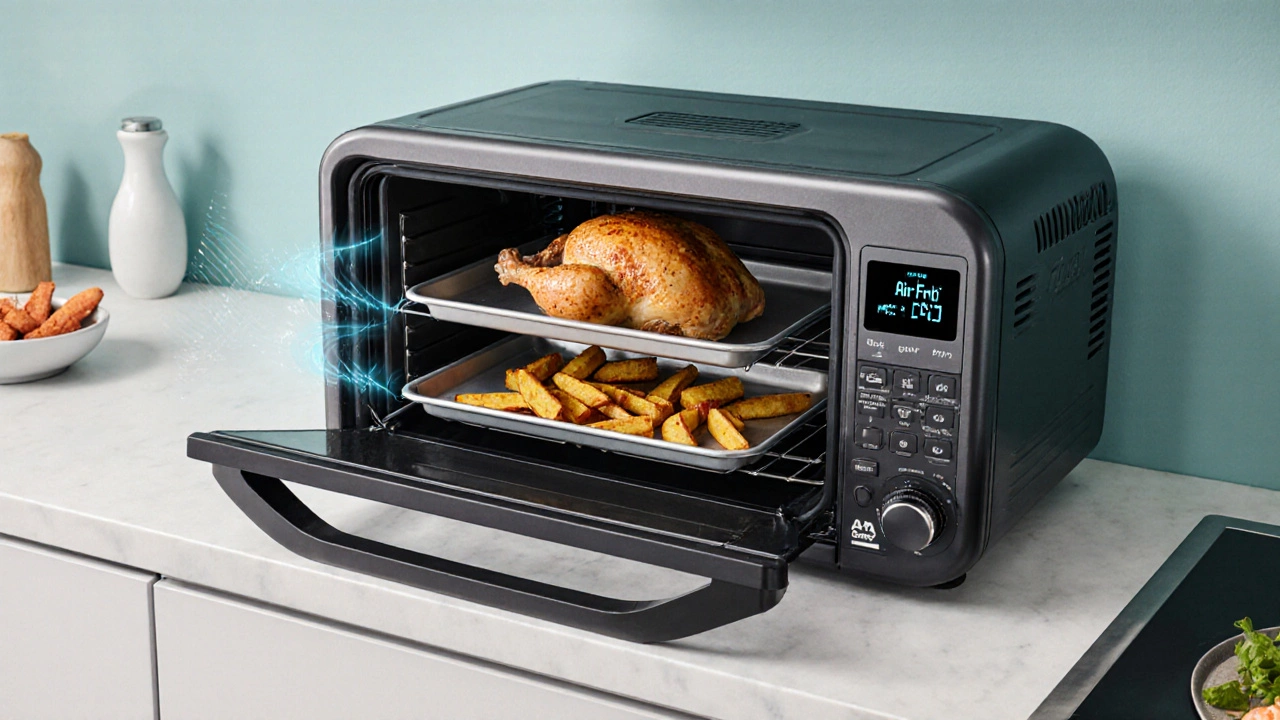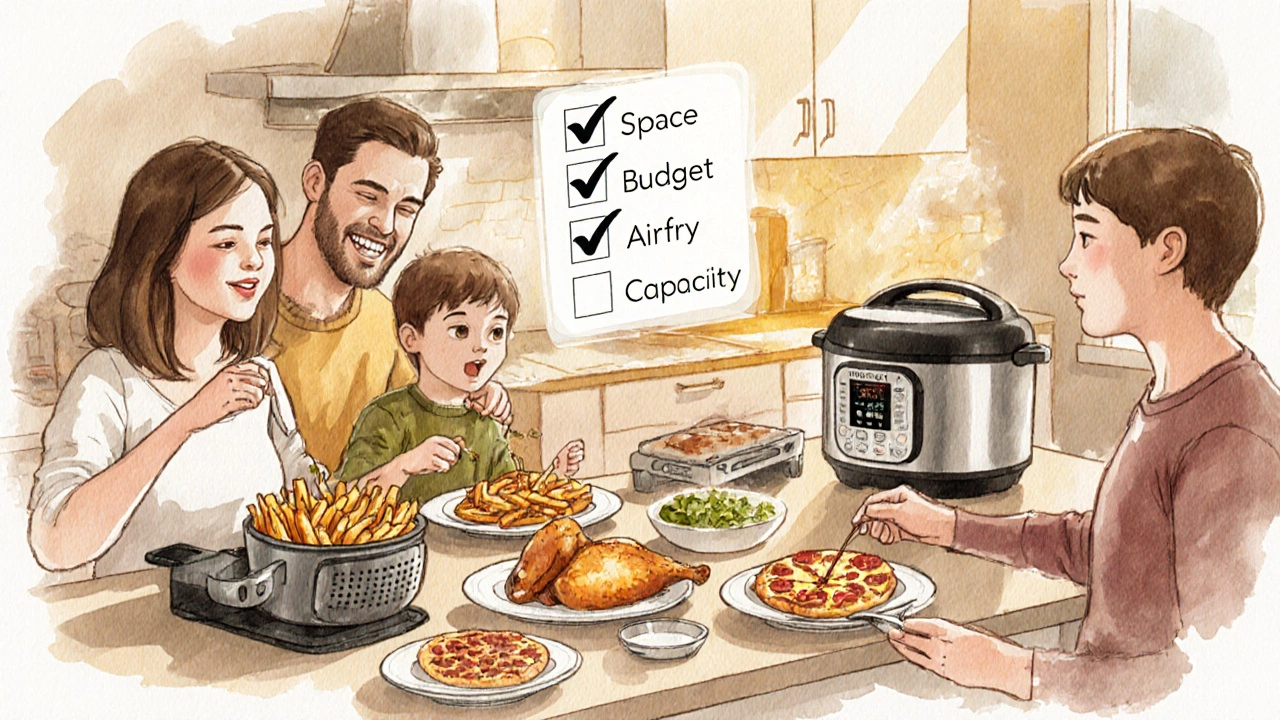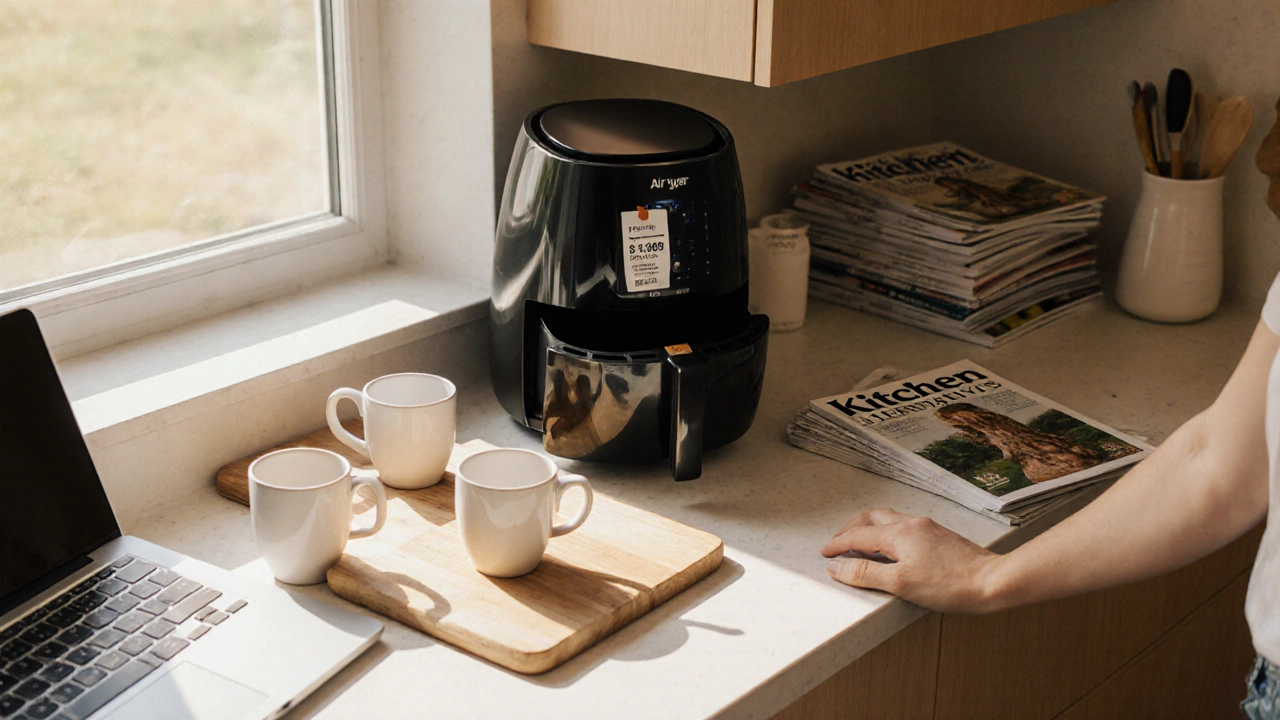Air fryers have been a kitchen staple for the past few years, but rising prices, limited capacity, and the desire for multi‑function tools push many shoppers to look elsewhere. Below you’ll find the most popular substitutes, why people choose them, and how each one stacks up against a traditional air fryer.
Key Takeaways
- Convection ovens deliver the closest taste and texture to air fryers while offering larger capacity.
- Countertop ovens combine broiling, baking, and air‑frying in one compact box.
- Simple accessories like stovetop air‑fry pans or Instant Pot lids provide a low‑cost, space‑saving option.
- When comparing alternatives, focus on capacity, cooking speed, and price‑to‑feature ratio.
- Most alternatives can handle the same recipes - just adjust time and temperature by 10‑15%.
Air Fryer is a countertop appliance that circulates hot air at high speed to mimic deep‑fried results with a fraction of the oil. It typically offers 2-5 L of cooking space, preset programs, and a 30‑minute timer. While the technology is solid, users often cite three pain points: limited basket size, plastic‑on‑plastic buildup, and a price tag that can exceed $200 for premium models.
Why Look for an Alternative?
Several trends drive the shift away from dedicated air fryers:
- Space constraints. Small apartments and shared kitchens need multi‑purpose gear.
- Cost pressure. Seasonal sales can drop air fryer prices, but many alternatives already sit under $150.
- Cooking flexibility. Users want to bake, broil, and roast without swapping appliances.
- Performance quirks. Some models struggle with even browning or create uneven hot spots.
These factors open the door for a wide range of substitutes that already exist in most households.
1. Convection Oven (Full‑Size or Countertop)
Convection Oven is a traditional oven equipped with a fan that rapidly circulates hot air, achieving the same crisping effect as an air fryer but with a much larger interior. Key benefits include:
- Capacity ranging from 12 L (compact) to 45 L (full‑size), allowing a whole chicken or multiple trays.
- Temperature range up to 260 °C, useful for pizza and baking.
- Built‑in broil, roast, and bake functions, reducing the need for extra gadgets.
Popular models in 2025, such as the Breville BOV845BSS and the Ninja Foodi 9‑in‑1 Countertop Oven, sit between $180 and $350, delivering faster cooking times than a standard oven and similar crispness to an air fryer.
2. Countertop Multi‑Function Oven
These are essentially compact convection ovens packaged with additional cooking modes-air fry, slow‑cook, dehydrate, and even rotisserie. Brands like Cuisinart TOA‑60 and Instant Vortex Plus dominate the segment.
- Footprint under 12 × 12 in, perfect for dorm rooms.
- Digital controls with preset air‑fry programs.
- Price range $120‑$250, often cheaper than a dedicated air fryer with the same features.
Because they double as a toaster oven, they replace two kitchen tools at once, making them a top pick for budget‑conscious cooks.
3. Toaster Oven with Air‑Fry Feature
Modern toaster ovens now include a dedicated air‑fry mode, using a high‑velocity fan and heating elements on the top and bottom. The KitchenAid KCO255BM and the Hamilton Beach 31107 are two well‑reviewed options.
- Capacity up to 0.9 cu ft, enough for a family‑size pizza.
- Integrated crumb tray for easy cleanup.
- Typical price $100‑$180.
While they may not reach the same top‑end temperatures as a pure air fryer, the added toast and bake functions make them a versatile replacement.

4. Instant Pot® Air‑Fry Lid
For anyone who already owns the Instant Pot pressure cooker, the separate air‑fry lid transforms the unit into an air‑frying workstation.
- Attaches to any 6‑quart Instant Pot model.
- Uses up to 2000 W of power, delivering a crisp finish in 15‑20 minutes.
- Cost $70‑$90, far cheaper than buying a whole new appliance.
This option shines for small‑batch meals or when you need both pressure cooking and air frying without cluttering the countertop.
5. Stovetop Air‑Fry Pan
A non‑stick pan with perforated surfaces mimics the airflow of an air fryer. Brands like T-fal and Lodge sell 10‑inch models that sit directly on a burner.
- No electricity required beyond your stove.
- Works with any cooking oil, giving you full control over flavor.
- Price $30‑$50, the most affordable substitute.
The learning curve is low-just preheat the pan, add a thin layer of oil, and toss your food. It’s a great backup when electricity is limited.
6. Grill or Grill Pan
Cast‑iron grills or ridged grill pans create a sear that mimics the crunchy exterior of air‑fried foods. While they don’t circulate air, the high direct heat caramelizes the surface.
- Provides smoky flavor when used on a gas or charcoal grill.
- Can handle larger cuts of meat that air fryers struggle with.
- Cost $25‑$80.
Combine with a light spray of oil, and you’ll get pork chops and veggie sticks that feel almost identical to an air‑fried version.
7. Microwave with Crisp Technology
High‑end microwaves now feature a “Crisp” or “Air‑Fry” mode that uses a combination of microwaves, convection, and a specialized metal grill plate.
- Brands like Panasonic NN‑SF770S and LG NeoChef offer this feature.
- Speeds up cooking compared to a standard microwave, usually under 10 minutes for frozen snacks.
- Price ranges $250‑$450, but you also gain rapid reheating and defrosting capabilities.
If your kitchen already has a premium microwave, this mode often eliminates the need for a separate air fryer.

Choosing the Right Substitute - Quick Checklist
- Kitchen space. If you have a dedicated countertop, a convection oven or multi‑function oven fits best. For tight spaces, consider a stovetop pan or Instant Pot lid.
- Budget. Under $100? Go for a grill pan or air‑fry pan. $100‑$200? A toaster oven with air‑fry or a countertop oven. $200+? Full‑size convection oven or premium microwave.
- Cooking volume. Need to fry a family‑size batch? Choose a convection oven. For single‑serve snacks, a pan or lid works fine.
- Additional features. If you also want to bake, broil, or dehydrate, pick a multi‑function countertop oven.
Comparison Table
| Alternative | Typical Price (USD) | Capacity | Cooking Speed | Pros | Cons |
|---|---|---|---|---|---|
| Convection Oven (full‑size) | $180‑$350 | 12‑45 L | Fast (15‑25 min for fries) | Large, versatile, even browning | Bulky, higher power draw |
| Countertop Multi‑Function Oven | $120‑$250 | 0.9‑1.35 cu ft | Comparable to air fryer | Multiple cooking modes, compact | Learning curve for presets |
| Toaster Oven with Air‑Fry | $100‑$180 | 0.8‑0.9 cu ft | Slightly slower (20‑30 min) | Toast & bake in one | Limited max temp |
| Instant Pot Air‑Fry Lid | $70‑$90 | 6‑qt pressure pot | Fast (15‑20 min) | Dual‑use, space‑saving | Requires Instant Pot base |
| Stovetop Air‑Fry Pan | $30‑$50 | Fits 1‑2 servings | Fast (10‑15 min) | Very cheap, no electricity | Manual temp control, small batch |
| Grill/Grill Pan | $25‑$80 | Variable | Fast sear | Smoky flavor, high heat | Doesn’t mimic air circulation |
| Microwave with Crisp | $250‑$450 | Standard microwave cavity | Very fast (5‑12 min) | Multi‑use, reheats instantly | Expensive, metal plate needed |
Real‑World Example: Replacing an Air Fryer for a Family of Four
Emily from Vancouver swapped her $229 Ninja Air Fryer for a Ninja Foodi 9‑in‑1 countertop oven. She needed to cook a whole chicken, a batch of sweet potatoes, and a tray of frozen fish sticks each week. The new oven handled all three items simultaneously, cutting her cooking time by 20% and saving $40 per year on electricity compared to running the air fryer twice a day.
Meanwhile, her roommate Jake kept his $75 Instant Pot with the air‑fry lid for single‑serve breakfasts like avocado toast and crispy tofu. He appreciates the low footprint and the fact he can pressure‑cook oatmeal in the same pot.
How to Transition Smoothly
- Identify which cooking tasks you do most often (e.g., fries, chicken wings, baked goods).
- Match those tasks to the alternative that offers the best capacity and speed.
- Start with a single purchase; many alternatives double as existing appliances.
- Adjust recipes: lower temperature by 10‑15 % and add 2‑5 minutes to the original air‑fryer time.
- Test with a familiar snack (frozen fries) to calibrate crispness.
Can a regular oven replace an air fryer?
Yes, if you use the convection setting. A convection oven circulates hot air similarly to an air fryer, but you’ll need a slightly longer cooking time and a tray instead of a basket.
Is a stovetop air‑fry pan safe for non‑stick cooking?
Most stovetop pans use a perforated stainless‑steel surface, which avoids the wear issues of non‑stick coatings. Just follow the manufacturer’s heat‑level guidelines.
Do toaster ovens with air‑fry mode consume as much power as a dedicated air fryer?
Typically, they draw slightly more watts (around 1500‑1800 W) compared to 1300‑1500 W for most air fryers. The difference in your electricity bill is minimal unless you use it daily for long periods.
Can I still get that “fried” texture without any oil?
A tiny spray of oil (about ½ teaspoon) is enough for most alternatives. The hot air or direct heat does the crunching; the oil just helps with browning.
Which alternative is best for someone who already owns an Instant Pot?
The Instant Pot Air‑Fry lid is the most cost‑effective choice. It adds air‑frying capability without taking up counter space and integrates with your existing pressure‑cooking recipes.
Bottom line: you don’t have to stick with a single‑purpose air fryer. Whether you need more capacity, a lower price, or extra cooking modes, one of these alternatives will fit your kitchen and your wallet.

